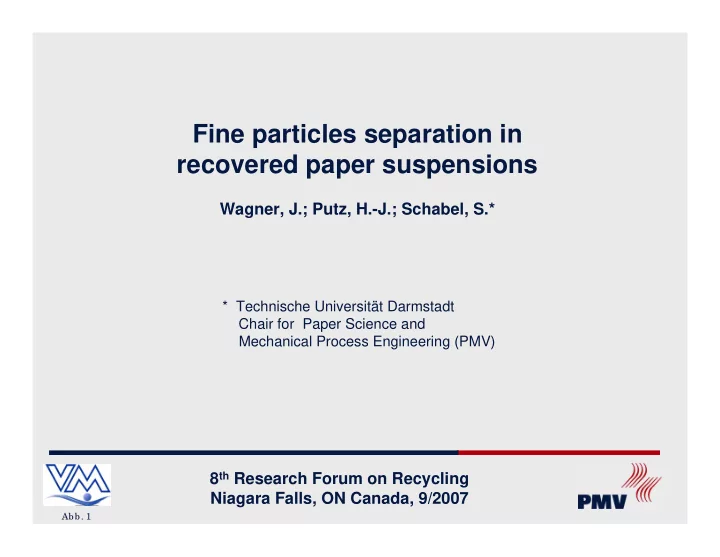

Fine particles separation in recovered paper suspensions Wagner, J.; Putz, H.-J.; Schabel, S.* * Technische Universität Darmstadt Chair for Paper Science and Mechanical Process Engineering (PMV) 8 th Research Forum on Recycling Niagara Falls, ON Canada, 9/2007 Abb. 1
� Introduction: Why separating organic from anorganic fines? � How to quantify progress: Why lack of measurement techniques is a major problem � Our approach for measurement: - particle size distribution - settling velocity - image analysis � Separation results Overview Abb. 2
Raw material consumption in 2005 in Germany: 25.5 million tons for 21.7 million tons paper production chemical pulp 20% mechanical pulp 7% chemical additives 4% recovered paper 56% fillers and coating pigments 13% Raw materials for paper production Abb. 3
• Packaging paper - Pulp - Filtrate from thickeners - Filtrate from paper machine wire • Graphic paper - Flotation foam and sludge • Tissue paper - Washer filtrate Recovered paper suspensions to be considered Abb. 4
Inorganic and organic components in a flotation foam of a stock preparation for graphic recycling paper Abb. 5
• Inorganic fines from fillers and coating pigments cause lower strength properties fibre binding area inorganic components • Effect of organic fines depends on surface condition: degree of fibrillation strength properties • Flotation and washing separate both components from longer fibre material � low selectivity, losses during paper production Fines in recovered paper suspensions Abb. 6
• Sedimentation-Balance h • Sedi-Graph (X-Ray) • Manometer-Centrifuge • Laser-Diffraction • FiberLab How to quantify progress Abb. 7
w3 Cylinder height in ml 250 ml 120 ml 38 ml chemical pulp fines chemical pulp fines calcium carbonate + calcium carbonate Observing sedimentation of virgin components Abb. 8
Slide 8 w3 Sedimentationsgeschwindigkeiten ausrechnen und dazuschreiben wimi, 11/18/2006
coated paper fines uncoated paper fines mechanical pulp fines 80 % inorganic 50 % inorganic 0 % inorganic Sedimentation balance Abb. 9
5 Coated paper gestrichenes Papier Coated paper + GW gestrichenes Papier + Schliff 4.5 GW Schliff TMP 4 CaCO3 Rel. frequency in % 3.5 Volumen in % 3 2.5 2 1.5 1 0.5 0 0.1 1 10 100 1000 10000 Size of equivalent sphere in µm äquivalenter Kugeldurchmesser in micrometer Equivalent particle diameter in µm Particle size distributions measured with laser diffraction Abb. 10
1 0,9 0,8 Difference should be Mass distribution sum 0,7 Utilizable for 0,6 separation 0,5 0,4 CaCO3 + Fines I CaCO3 + Fines II 0,3 CaCO3 + Fines III 0,2 CaCO3 0,1 Chem. Pulp Fines 0 0,001 0,01 0,1 1 10 Sedimentation velocity in mm/s Measuring sedimentation of components with a sedimentation balance Abb. 11
Sinkgeschwindigkeit, Papier ungestrichen, normiert auf g 1,0 0,9 0,8 Mass distribution sum 0,7 0,6 0,5 Ma% 50g manometer centrifuge Q3 1 Ma% 50 g 0,5 at x % consistency 2 Ma% 50 g 0,4 3 Ma% 50 g 0,3 sedimentation balance Sediwaage 3,7 Ma% at 3.7 % consistency 0,2 0,1 0,0 1,00E-07 1,00E-06 1,00E-05 1,00E-04 1,00E-03 1,00E-02 Sedimentation velocity in m/s Sinkgeschwindigkeit [m/s] Normalised on acceleration due to gravity g Uncoated paper fines’ settling velocities Abb. 12
1,0 0,9 0,8 Mass distribution sum 0,7 0,6 Q3 1 Ma% 50 g 0,5 manometer centrifuge 2 Ma% 50 g 0,4 at x % consistency 0,3 3 Ma% 50 g sedimentation balance 0,2 Sediwaage 3,7 Ma% at 3.7 % consistency 0,1 0,0 1,00E-07 1,00E-06 1,00E-05 1,00E-04 1,00E-03 1,00E-02 Sedimentation velocity in m/s Sinkgeschwindigkeit [m/s] Coated paper fines’ settling velocities Abb. 13
100 Mass distribution sum in % Sedimentation 90 balance 80 Sedigraph 70 60 50 40 30 20 10 0 0.1 1.0 10.0 100.0 Equivalent spheric diameter in µm Comparison of Sed. Balance and Sedigraph Abb. 14
luminous sedimentation cell source observation window: • width: 30 mm • height: 20 mm camera PCO 4000 technical data camera: • resolution: 4008 x 2672 single picture → particle size • frame rate: 5 frames/s series of pictures → sedimentation velocity • illumination time: 5 µs – 5 days Image analysis for sedimentation evaluation Abb. 15
Sequence Abb. 16
Sedimentation test rig Abb. 17
60 model suspension (fitrate coated paper + filtrate groundwood) 50 + 20,1 % ash content in % 40 - 10,6 % 30 36,4% 25,8% 56,5% 20 10 0 model suspension sediment overflow Separation results Abb. 18
filtrate flotation sludge untreated filtrate flotation sludge treated with ultrasonic 90 80 70 60 ash content in % 74,8 % 50 70,5 % 81,3 % 40 30 20 10 0 startsuspension sediment Latest Results with Mechnical Treatment Abb. 19
Latest Results: Visual Impression Abb. 20
• Sedimentation of fines in pulp suspensions is complex and measurement difficult • Combinations of measurement methods are necessary for evaluating all relevant effects • Most promising: combination of sedimentaion camera (organic particles) with sedimentation device (all particles) • Still open questions and unsolved problems remaining – disintegration and stabilisation seems to be essential Conclusions Abb. 21
Recommend
More recommend